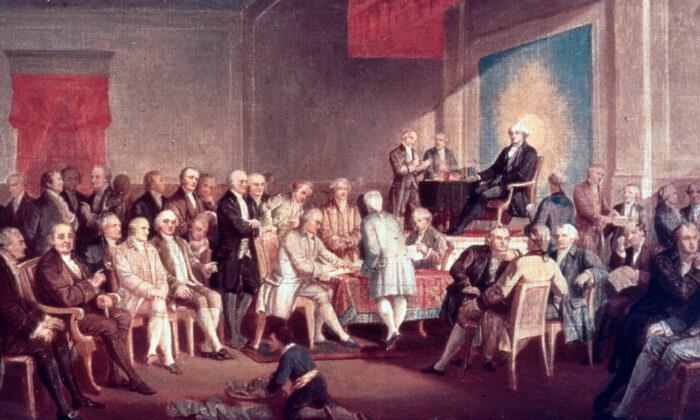The most important checks and balances in our constitutional system derive from the split authority between the federal government and the states. As the federal government has grown in power, state “pushback”—which James Madison called “interposition”—has become more important than ever.
Conventions of States
A convention of states (or convention of the states) is a meeting of state delegations, each with equal voting power. The Constitution’s framers adopted this device as a way to propose amendments to the document. For example, in a recent Epoch Times essay, I explained how a convention could propose an amendment reclaiming public health policy from the federal government. Although the states have not used the convention mechanism to propose an amendment, 12 of the 27 amendments—including the Bill of Rights—were proposed by Congress only because states threatened to force an amendments convention if Congress didn’t do so.Most of these gatherings have been regional, but others have been national or “general.” The latter included meetings in 1754, 1765, 1774, 1780, 1787, 1861, and 2017. The 1786 Annapolis convention, although poorly attended, also qualifies as general. A convention for proposing amendments would be general.
Successful and Unsuccessful Conventions
As you might expect, some interstate conventions have been successful while others have not.Among the unsuccessful ones were those that addressed monetary inflation during the Revolutionary War, an 1814 convention in Hartford, Connecticut, and an 1850 gathering in Nashville, Tennessee. The latter two were convened to protest federal policies.
- The conclave that drafted the Constitution, held in Philadelphia in 1787.
- A nine-state gathering in St. Louis in 1889 on monopolistic practices. Its recommendations led to the enactment of state antitrust laws and the federal Sherman Antitrust Act.
- Several Western water law conventions in the first half of the 20th century. They drafted the Colorado River Compact, the Upper Colorado River Basin Compact, and the Rio Grande Compact. They were the brainchild of Denver lawyer Delphus E. Carpenter, who wanted the states to allocate their own water rather than having the federal government do it for them.
- The 2017 general convention in Phoenix, which updated proposed convention rules (pdf).
Cooperation Through Permanent Commissions
Conventions are, by definition, temporary assemblies. They are called, they convene, they deliberate, and they propose (or not). Then they adjourn permanently. But states also cooperate through more permanent structures. These are usually called “commissions.”Cooperation Through Interstate Compacts
The states enter into interstate compacts (i.e., contracts) to administer a range of services, such as infrastructure, water allocation, environmental protection, natural resource conservation, and interstate parks. An illustration is the Palisades Interstate Park Compact (pdf), between New York and New Jersey, to administer a sprawling and beautiful park in the Hudson River Valley.In theory, states can use compacts to “interpose” against federal power. As just noted, for example, the Western water compacts were adopted to forestall federal interference. Similarly, a group of states might enter a compact pledging that none of them will allow state employees to enforce an overreaching federal law.
A drawback is that for interstate compacts to be enforceable legally, the Constitution requires that they be approved by Congress (Art. I, Section 10, Clause 3). Some congressional majorities might approve compacts that challenge congressional power, but most will not.
Cooperation Through Independent Organizations
State officials and lawmakers meet and cooperate through the National Conference of State Legislatures, the Council of State Governments, and the American Legislative Exchange Council (ALEC). These organizations hold conferences at which state officials obtain information and compare notes. They also assist in drafting proposed legislation.Of the three, ALEC has been the most focused on federalism, including the need to restrain federal growth. Not surprisingly, therefore, ALEC has sometimes been demonized by the political left.
Bottom line: Interstate cooperation isn’t a rarity. It’s a commonplace reality. States wishing to restrain federal intrusion into areas of state jurisdiction have various ways of cooperating.





